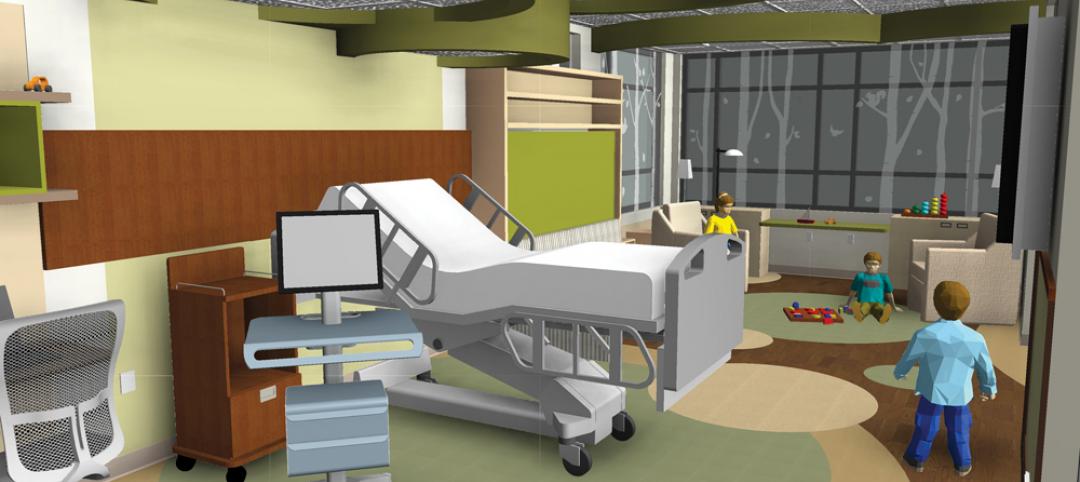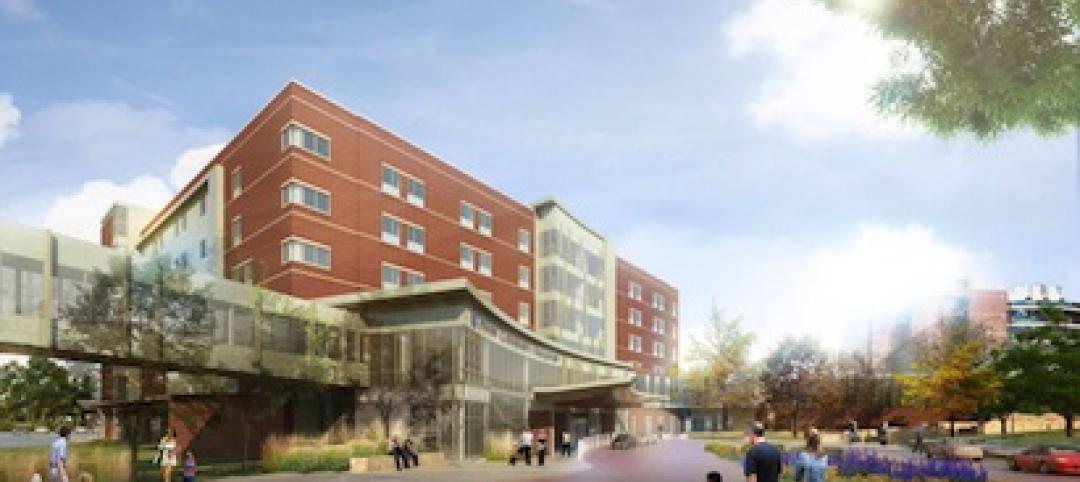Faced with the complexities of value-based payment models and the uncertainties surrounding healthcare reform, the nation's healthcare delivery systems are taking the long view of their operations.
“They're looking at everything from organizational structures, staffing, and services, all the way down to the cost of building and operating a facility,” says Mike Zorich, PE, LEED AP, Client Executive with engineering firm IMEG.
Case in point: Boston Medical Center's multi-year campus consolidation will trim its footprint by 60 beds and 329,000 sf, saving $25 million a year in operating costs.
See also: Top 160 Healthcare Architecture + AE Firms - 2018 Giants 300
See also: Top 90 Healthcare Engineering + EA Firms - 2018 Giants 300
See also: Top 105 Healthcare Construction + CM Firms - 2018 Giants 300
Academic medical centers are also modernizing. The IPD team for Sutter Health’s California Pacific Medical Center, San Francisco—which includes SmithGroupJJR, Boulder Associates, and HerreroBOLDT—is building two replacement hospitals, closing an existing campus, and converting another one from inpatient to outpatient care.
“We are quickly transitioning from patient-centered to patient-driven care,” says Heather Chung, EDAC, LEED AP, VP/Health Studio Leader, SmithGroupJJR. “Patients are changing what it means to be accessible and convenient and are shaping what healthcare providers deliver.”
“The healthcare market continues to reach further into communities and away from the traditional hospital for many front-line services,” says IMEG’s Zorich. “Healthcare buildings used to be designed for more than 50-year life spans, but many of the smaller off-campus outpatient facilities are now looking at 20 years or less.”
An emphasis on reducing costs and improving efficiency is fueling the use of Lean construction and prefabrication.
Prefab helped Skanska shave more than $200,000 in construction costs off a 444,000-sf hospital expansion at the University of Virginia Health System, Charlottesville. “Laser scanning identified opportunities for the prefabrication of materials alongside critical in-place infrastructure that could not be interrupted,” says Andrew Quirk, Senior Vice President and National Director of Skanska USA’s Healthcare Center of Excellence.
AEC firms are also stepping up the use of VR and AR tools. “Not only can VR and AR help our clients understand department layouts, adjacencies, workflows, and finishes during the design process, but clients can continue to use these tools to maintain and operate their facilities more efficiently,” says Mike Stapf, Vice President, Design Integration, McCarthy Building Companies.
doubling down ON RESILIENCE, collaboration
Resilience is guiding the design of healthcare facilities, particularly in regions vulnerable to extreme emergency events. “Healthcare facilities need to maintain services during and after extreme events, and this drives priorities in a very different direction than before,” says Pat Bosch, LEED AP, Design Director, Perkins+Will, Miami.
In South Texas, P+W is leading the expansion of Christus Spohn Hospital Corpus Christi–Shoreline, a pilot project using the RELi rating system. RELi helps project teams plan for hazards and emergencies that could cut power and heat or compromise a building’s functionality.
The hospital's leaders recognized the facility's role as a regional command center in the event of a natural disaster or terrorist threat and as a place of refuge. "They identified resilient design as a top priority," says Julie Frazier, Associate Principal, Perkins+Will, Dallas.
Masonry skin, impact-resistant glazing, and galvanized exposed metals will protect the 10-story structure during extreme events. If HVAC systems are knocked out of service, reflective roof surfaces will minimize heat gain; sun-shading devices will filter natural sunlight on patient floors. Several days' provision of food and water will be stocked.
Another new healthcare design trend: translational medicine, which brings researchers and clinicians under the same roof to hasten discoveries that accelerate individualized patient treatments.
“Just as the AIDS epidemic needed a new way of thinking, cancer care and clinical care in general need a new way to take advantage of advanced technology and research methods to deliver innovative, personalized care and treatment for their patients,” says Hank Adams, AIA, ACHA, EDAC, Global Director of Health at HDR.
Transdisciplinary integration is breaking down the physical and organizational barriers that have traditionally separated these areas, to speed up the development of life-saving therapies.
“The merging of patient care, education, and science into one contiguous platform is the future of academic medicine,” says Scott Rawlings, AIA, FACHA, LEED AP, Director of Healthcare with HOK.
“Leading institutions are finding that focusing superspecialties into one building that combines clinical care, trials, research, and education enables them to quickly translate basic research findings into prevention and treatment and to enhance patient care,” says Rawlings.
Related Stories
| Nov 19, 2013
Pediatric design in an adult hospital setting
Freestanding pediatric facilities have operational and physical characteristics that differ from those of adult facilities.
| Nov 19, 2013
Top 10 green building products for 2014
Assa Abloy's power-over-ethernet access-control locks and Schüco's retrofit façade system are among the products to make BuildingGreen Inc.'s annual Top-10 Green Building Products list.
| Nov 18, 2013
6 checkpoints when designing a pediatric healthcare unit
As more time and money is devoted to neonatal and pediatric research, evidence-based design is playing an increasingly crucial role in the development of healthcare facilities for children. Here are six important factors AEC firms should consider when designing pediatric healthcare facilities.
| Nov 15, 2013
Greenbuild 2013 Report - BD+C Exclusive
The BD+C editorial team brings you this special report on the latest green building trends across nine key market sectors.
| Nov 15, 2013
Pedia-Pod: A state-of-the-art pediatric building module
This demonstration pediatric treatment building module is “kid-friendly,” offering a unique and cheerful environment where a child can feel most comfortable.
| Nov 14, 2013
Behind the build: BD+C's 'Pedia-Pod' modular pediatric patient unit at Greenbuild 2013 [slideshow]
Next week at Greenbuild, BD+C will unveil its demonstration pediatric patient unit, called Pedia-Pod. Here's a behind-the-scenes look at the construction of this unique modular structure.
| Nov 13, 2013
Installed capacity of geothermal heat pumps to grow by 150% by 2020, says study
The worldwide installed capacity of GHP systems will reach 127.4 gigawatts-thermal over the next seven years, growth of nearly 150%, according to a recent report from Navigant Research.
| Nov 8, 2013
Oversized healthcare: How did we get here and how do we right-size?
Healthcare facilities, especially our nation's hospitals, have steadily become larger over the past couple of decades. The growth has occurred despite stabilization, and in some markets, a decline in inpatient utilization.
| Nov 1, 2013
CBRE Group enhances healthcare platform with acquisition of KLMK Group
CBRE Group, Inc. (NYSE:CBG) today announced that it has acquired KLMK Group, a leading provider of facility consulting, project advisory and facility activation solutions to the healthcare industry.
| Oct 30, 2013
15 stellar historic preservation, adaptive reuse, and renovation projects
The winners of the 2013 Reconstruction Awards showcase the best work of distinguished Building Teams, encompassing historic preservation, adaptive reuse, and renovations and additions.

















